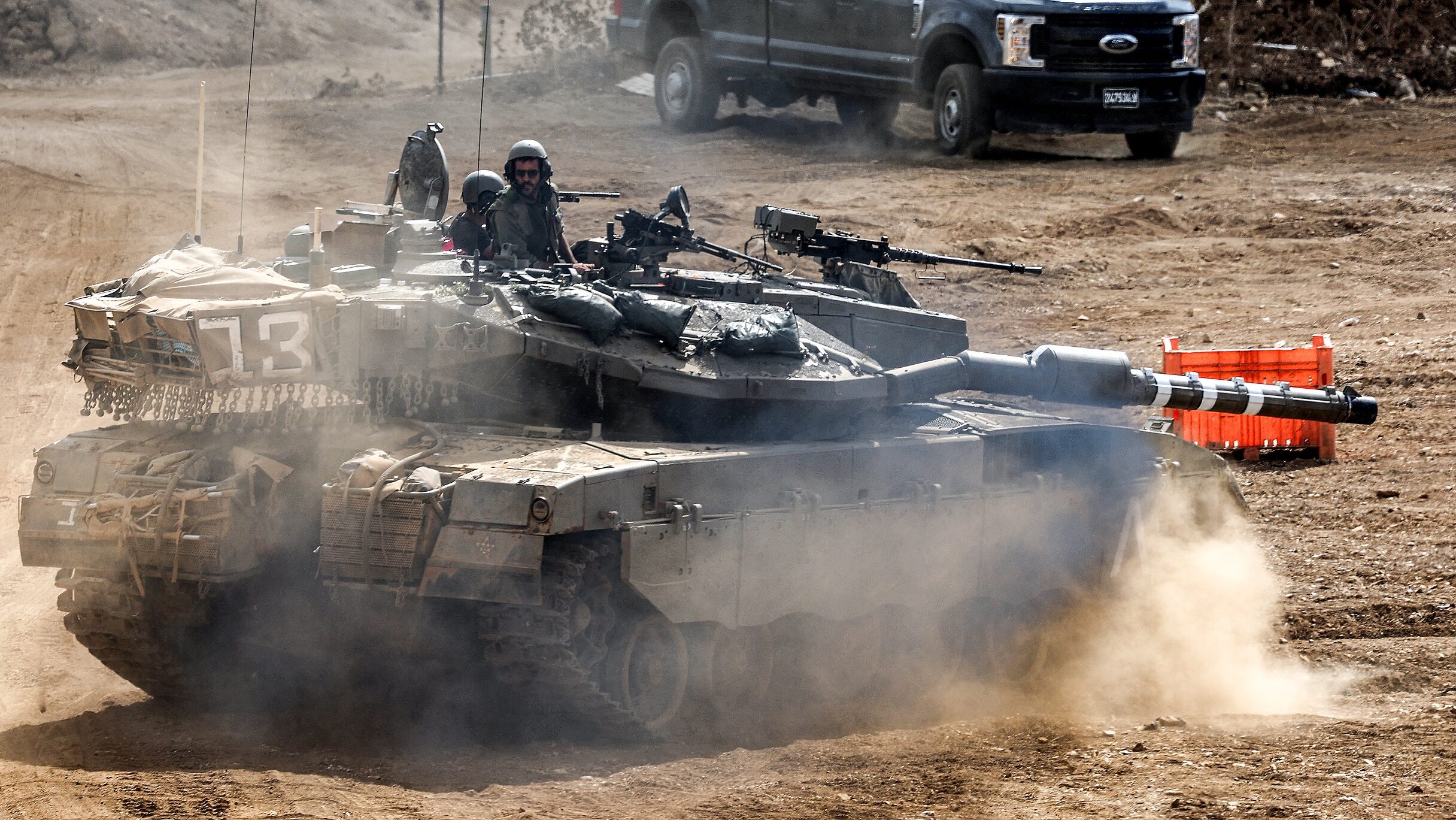Israel Sees Ground Invasion of Lebanon as Necessary To Complete Mission Against Hezbollah
Israel launched targeted ground raids against Hezbollah in Lebanon, with artillery support, after the killing of leader Hassan Nasrallah. Citizens near the border are urged to stay near shelters as tensions rise.
The Israeli army pounded southern Lebanon with massive artillery fire on Tuesday as its ground troops began an invasion of the country. The Israel Defense Forces (IDF) announced late Monday that its forces had begun “limited, localized, and targeted ground raids based on precise intelligence against Hezbollah terrorist targets and infrastructure in southern Lebanon. These targets are located in villages close to the border and pose an immediate threat to Israeli communities in northern Israel.”
Israeli citizens living near the Lebanese border have been instructed to stay close to bomb shelters, and some areas have been designated as closed military zones. Meanwhile, the United Nations reported that 1 million people in Lebanon have been displaced, with 100,000 fleeing to neighboring Syria.
The soldiers entered Lebanon days after the IDF assassinated the leader of the Lebanese-based, Iranian-backed Hezbollah terrorist group, Hassan Nasrallah, in an airstrike in Beirut.
For decades, Hezbollah is believed to have invested in a widespread underground tunnel network aimed to be used as a springboard to attack Israel. While its stockpile of missiles has been significantly downsized through hundreds of airstrikes, the tunnel network and Hezbollah’s large presence in villages on the border with Israel merits a ground operation, according to senior defense officials.
There are two main goals for this operation: to remove Hezbollah with its high-level military capabilities … and to rid it of its ability to execute a massacre
“There are two main goals for this operation,” Sarit Zehavi, founder and president of the Alma Research and Education Center, which specializes in terrorism studies, told The Media Line. “The first is to remove Hezbollah with its high-level military capabilities as a strategic threat, and the second is to rid it of its ability to execute a massacre against Israelis through its tunnels, which also house major ammunitions depots, including a large number of anti-tank missiles.”
According to Zehavi, the Israeli military has had “impressive achievements.” While Hezbollah has suffered losses in commanders, infrastructure, and missile capabilities, it still retains the ability to strike Israel.
The Israeli government has outlined its goals in the conflict, including military objectives and the resettlement of around 60,000 displaced Israeli residents near the Lebanon border. These residents were evacuated last year when Hezbollah joined Hamas in fighting Israel.
Hezbollah entered the conflict a day after the Hamas offensive, pledging to oppose Israel as long as its operations in Gaza continued. The group has since fired over 9,000 rockets into Israel, killing 49 people and wounding nearly 400. As Israel escalated its operations against Hezbollah, the Lebanese Health Ministry reported over 1,000 deaths and thousands of injuries.
Israel’s operation in Lebanon comes almost a year after its war against Hamas in the Gaza Strip. That war began when Hamas launched a surprise attack on Israel on October 7 of last year, killing around 1,200 Israelis and taking 250 hostages. A year later, 101 of the hostages remain in Hamas custody, their fate unknown. According to the Hamas-run Gaza Health Ministry, over 41,000 Palestinians have been killed and nearly 100,000 injured by Israeli military operations.
Despite taking major blows, Hezbollah continues to fire at Israel, some days more than 100 missiles a day. On Tuesday, rockets fired from Lebanon reached central Israel, showing Hezbollah still possesses long-range capabilities. Communities closer to the border face daily attacks, and while Israel’s air defense systems have exceptionally high interception rates, the Israeli government and citizens refuse to accept these assaults as routine.
This holiday season, give to:
Truth and understanding
The Media Line's intrepid correspondents are in Israel, Gaza, Lebanon, Syria and Pakistan providing first-person reporting.
They all said they cover it.
We see it.
We report with just one agenda: the truth.


Hezbollah has dispersed its missiles all over Lebanon, and it will not be easy to disarm it.
“This does not allow the resumption of normal life,” said Zehavi. “Hezbollah has dispersed its missiles all over Lebanon, and it will not be easy to disarm it.”
Hours before the ground invasion, Nasrallah’s deputy and the current acting leader of Hezbollah said the terrorist group was ready for the Israeli troops.
“If Israel decides to launch a ground offensive, Hezbollah fighters are ready to fight and defend Lebanon,” Naim Kassem threatened in a televised address. Kassem, who wiped the sweat off his face in a nervous speech, was one of the few remaining Hamas leaders who have survived a series of recent losses in a long string of targeted killings conducted by Israel. Kassem added that all of them had already been replaced.
In late 2018, the Israeli military uncovered what it said were four cross-border tunnels dug by Hezbollah to infiltrate Israel. Residents of border communities had reported drilling noises for years before the tunnels were revealed. This finding was believed to be just the tip of the iceberg. The scenes of Hamas terrorists storming the border with Israel from Gaza were the materialization of a nightmare residents of northern Israel have long had.
While the assassination of Nasrallah dealt a major blow to Hezbollah, Israeli officials have warned this is only the beginning of their response to the group’s threat.
“After October 7, Israel refuses to accept terrorists at its borders, realizing that this could lead to a massacre,” Dr. Harel Chorev, a research fellow at the Moshe Dayan Center for Middle Eastern and African Studies at Tel Aviv University, told The Media Line. “Israel is aware of Hezbollah’s intentions and has substantiated suspicions about its intentions. In order to prevent a repeat of last year’s scenes in Gaza, there is a need for incursions in order to prevent Hezbollah from using the tunnels to execute such an attack.”
Over the past year, Israel has conducted thousands of airstrikes against Hezbollah targets in Lebanon.
“Hezbollah turned Lebanese villages next to Israeli villages into military bases all ready for an attack on Israel,” IDF spokesperson Rear Admiral Daniel Hagari said in a video statement on Tuesday. “Hezbollah had prepared to use those villages as staging grounds for an October 7-style invasion into Israeli homes.”
Chorev assesses that while Israel has made a major dent in Hezbollah’s capabilities, the group’s ground forces remain largely intact and capable of attacking Israel Israel despite a temporary lack of a coherent command. Hezbollah’s elite Radwan forces, in particular, are believed to be still operational.
“This cannot be done only by airstrikes,” Chorev said. “What we have seen is a year of softening the area, also with artillery fire, and while Israel has damaged a lot of infrastructure, some things cannot be achieved from afar or from the air. There is no choice but to enter with ground forces.”
What we have seen is a year of softening the area, also with artillery fire, and while Israel has damaged a lot of infrastructure, some things cannot be achieved from afar
Israeli military officials have been cautious in framing expectations, emphasizing the operation’s limited scope in both time and depth.
“There will not be a once-and-for-all solution here,” said Zehavi. “For that, the Lebanese people need to give up their radical ideology. The aim is to shrink Hezbollah back to its abilities as a small terrorist organization and not a terror military. This means the border areas need to be completely cleaned.”
In recent decades, with massive Iranian backing in the form of funds, training, and weapons supply, Hezbollah has grown substantially. The recent blows exacted by Israel have damaged this lengthy effort and also damaged Hezbollah’s image throughout the Middle East. The series of successful strikes has also exposed what appears to be a deep penetration of Israeli intelligence into the organization. This is likely the culmination of years of effort.
“The evacuation of tens of thousands of residents from their homes is a strategic threat and bringing them home is a way to remove this threat,” Zehavi added. “Part of this removal is also the tarnishing of its image, which is equally important.”
Israel has a long history with Lebanon, including two wars and a lengthy occupation of southern Lebanon to maintain a buffer zone. The last ground invasion occurred nearly 20 years ago during a monthlong war with Hezbollah.
“The main lesson learned was not to return to the mistake of a buffer zone, not to stay long as sitting ducks,” said Chorev. “This is why Israel must adopt the method of pinpointed incursions.”
For now, the Israeli military stresses the limited nature of the current ground operations in Lebanon.
“The army has been preparing for this moment from the end of the last war in Lebanon,” Zehavi said.



